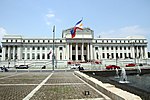Baluarte de San Andres
Buildings and structures in IntramurosForts in the PhilippinesSpanish colonial fortifications in the PhilippinesTourist attractions in Manila

The Baluarte de San Andres is a bastion in Intramuros, which is a part of the Spanish colonial fortification in the historic Walled City. It was built in 1603 to protect the Puerto Real and the southeastern part of Intramuros. It was also known as Baluarte De San Nicolas because it was located just in front of the Iglesia de San Nicolas de Tolentino, which is now the site of the present-day Manila Bulletin Building.
Excerpt from the Wikipedia article Baluarte de San Andres (License: CC BY-SA 3.0, Authors, Images).Baluarte de San Andres
Muralla Street, Manila
Geographical coordinates (GPS) Address Nearby Places Show on map
Geographical coordinates (GPS)
| Latitude | Longitude |
|---|---|
| N 14.58698 ° | E 120.97872 ° |
Address
Baluarte De San Andres
Muralla Street
1002 Manila (Fifth District)
Philippines
Open on Google Maps









